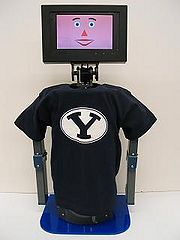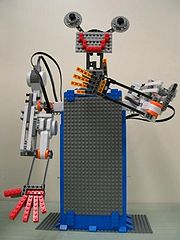Table of Contents
Welcome to the TiLAR Wiki. TiLAR stands for Therapist in the Loop Assistive Robotics. It is the working name for our efforts to use robots to help children with social learning disabilities.
The hypothesis behind this proposal is that children with ASD and SLI can benefit from interacting with a robot that: 1) occupies the same physical space as the child, 2) can move to increase engagement, and 3) can dynamically express social cues that may be ambiguous using only verbal stories and pictures. There is mounting evidence in the field of human-robot interaction that robots induce strong social responses in people. This social response is being studied by researchers as a potential intervention for helping children with autism become more sensitive and better able to respond to social cues.
The social response induced by robots is thus a potential tool for helping both typical children and children with disabilities. Many current research efforts are seeking to build fully autonomous robots to fill such roles, but the responsiveness of such robots is typically limited to simple algorithmic responses. We hypothesize that including a therapist or teacher “in the loop” to choreograph the interactions that take place will allow the robot to better support imitation-based therapies for children with learning disabilities. Developing technologies to test this hypothesis is possible by uniting three prior research threads: Honda’s autonomous imitation capabilities, BYU’s clinical experience in understanding, diagnosing, and providing therapies for children with SLI and ASD, and BYU’s experience in developing user interfaces and robotic technologies to support effective human-robot interaction. This work is sponsored by a 2008 BYU Mentored Environment Grant and a 2008 Honda Initiation Grant.
Current Events
- Tyler's Presentation at the 2012 SRC can be found here: http://students.cs.byu.edu/~tgill2/SRCPresentation2012.pptx
- The HONDA imitation for Troy is working! Here's the video: Video (35 MB wmv)
- A paper by David Feil-Seifer and Maja Mataric presented at HRI2011: Automated detection and classification of positive vs. negative robot interactions with Children with autism using distance-based features
- Upcoming Meetings
- 2/25/11 (Friday), 3:00-4:00 pm, ME Conference Room
- 3/25/11 (Friday), 3:00-4:00 pm, ME Conference Room
- Past Meetings — Follow this link to read past meetings notes.
Team Members and Collaborators
- Mechanical Engineering Department: Prof. Mark Colton, Nicole Giullian, Michael Plooster, Samantha Ruggles
- Computer Science Department: Prof. Michael Goodrich, Prof. Bryan Morse, Alan Atherton, Lanny Lin, Timothy Major, Robert Brown, Sterling Hurd, Tyler Gill
- Communication Disorders Department: Prof. Bonnie Brinton, Prof. Martin Fujiki, Prof. Lee Robinson, Stacey London, Katie Lowe, Alyssa Stabenow, Cambrie Roueche, Kristi Blanchard, Sarai Dodge
- Psychology Department: Prof. Mikle South
- MASDAR Institute of Science and Technology: Vimitha Manohar and Jacob Crandall
- Honda Research Institute, USA: Behzad Dariush, Kikuo Fujimura, Youding Zhu
- Project Alumni: Dan Ricks, Alan Olsen, Sukhbat Tumur-Ochir, Michelle Farmer, Maggie Hansen, Aersta Acerson
Research Objectives
- Investigate how robots can assist therapist in treating children with autism in clinical settings.
- Identify traits of the robots (form, shape, functions, etc.) that affect autistic children's behaviors.
- Design and develop human-robot interfaces that enable the therapists to choreograph (“program”) a robot's behaviors.
- Evaluate interaction techniques that improves the human-robot interaction.
Community Pages
Robots Used
- Humanoid Torso - Troy: the robot that has been used in the clinic with children
TiLAR Interface
Secure TiLAR Wiki Site
- This wiki site requires login and is used to post things not open to the general public. We can post things such as internal reports, discussions of cases, and project repository access information here. Secure TiLAR Wiki.
Links
A beautiful story about a girl with autism.
Behzad using retargeting with Asimo at IROS.
Robot Kinect Hacks from IEEE Spectrum.
A nice summary of work done with KASPAR. Note the allusions to generalization – pretty cool.
Babies treat robots as intentional beings.
Recent Popular Science article on robotics used for autism therapy
A robot that can tell when a human isn't paying attention
Web-Based Tool Produces Fast, Accurate Autism Diagnosis
Novel Mouse Model for Autism Yields Clues to a 50-Year-Old Mystery
Notes from a consciousness conference Specifically about hypnosis and illusions. The piece of most interest is near the bottom, about autism and illusions. Quote: “For instance, you might suspect that autistics, who tend not to focus so much on social cues, are somewhat protected from believing in illusions. Actually, the opposite is the case, and autistic people tend to fixate even more on faces than others during such illusions, and are more easily fooled. Exactly why this is the case is still a mystery.”
<!–
Getting started
Consult the User's Guide for information on using the wiki software. –>

